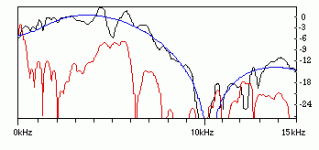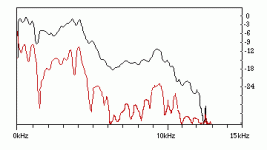I've been into DIY speaker building for quite a few years but have never been entirely competent with crossover design. Cabinet construction and bass tuning isn't too bad but evening out frequency response continues to be an issue!
At the moment i have a pair of Audax HM170CO woofers and have been looking to mate them with a smooth pair of soft dome tweeters. I guess i'm looking for recommendations bearing in mind that these will be the fronts for my home theatre system in a moderately large room (12' wide x 7.5' high x 16' long). Now one of my concerns is whether or not i can attain decent levels in a room of this size (the room isn't completed yet but will be in my basement) using only a pair of 6.5" woofers to cover midbass and higher (i've got the subwoofer part well taken care of). I did look at making the A652 MTM design by Vance Dickason but am unsure if the additional cost for 2 more woofers is worth the gain.
So...any ideas on tweeter choice, x-over design etc... or should i pick another design and save my pennies for building it later on?
Thanks!
Scott
At the moment i have a pair of Audax HM170CO woofers and have been looking to mate them with a smooth pair of soft dome tweeters. I guess i'm looking for recommendations bearing in mind that these will be the fronts for my home theatre system in a moderately large room (12' wide x 7.5' high x 16' long). Now one of my concerns is whether or not i can attain decent levels in a room of this size (the room isn't completed yet but will be in my basement) using only a pair of 6.5" woofers to cover midbass and higher (i've got the subwoofer part well taken care of). I did look at making the A652 MTM design by Vance Dickason but am unsure if the additional cost for 2 more woofers is worth the gain.
So...any ideas on tweeter choice, x-over design etc... or should i pick another design and save my pennies for building it later on?
Thanks!
Scott
Hi Scott,
Since nobody else has replied I'll say something so that if nothing else your post doesn't disapear off the current list 🙂
I'm kinda like you, have been DIY'ing for years but havent ever done any Xover design. Everyone seems to say build a kit that's already been worked out, but I guess sooner or later you need to bite the bullet and do something yourself.
Maybe you could use the tweeter in the A652, look at what freq it has been crossed at, and design your own xover which will give that Xover freq with 8 ohm load on the woofer (assuming here you don't go MTM).....
I'd start simple and tweak/modify/add as necessary till you are happy with the sound. Getting the attenuation right on the tweeter will probably be one of the the tricky parts. I cheated with my current speakers and installed some LPAD's (the nasty variable type 🙂 ), I guess you could use some of these and when you get the sound right measure the resistance values and substitute with discrete resistors, then put away the variable ones till next time, I don't know if this is a valid way of doing it, just something I've thought about but haven't actually tried yet.
Regards,
Tony.
Since nobody else has replied I'll say something so that if nothing else your post doesn't disapear off the current list 🙂
I'm kinda like you, have been DIY'ing for years but havent ever done any Xover design. Everyone seems to say build a kit that's already been worked out, but I guess sooner or later you need to bite the bullet and do something yourself.
Maybe you could use the tweeter in the A652, look at what freq it has been crossed at, and design your own xover which will give that Xover freq with 8 ohm load on the woofer (assuming here you don't go MTM).....
I'd start simple and tweak/modify/add as necessary till you are happy with the sound. Getting the attenuation right on the tweeter will probably be one of the the tricky parts. I cheated with my current speakers and installed some LPAD's (the nasty variable type 🙂 ), I guess you could use some of these and when you get the sound right measure the resistance values and substitute with discrete resistors, then put away the variable ones till next time, I don't know if this is a valid way of doing it, just something I've thought about but haven't actually tried yet.
Regards,
Tony.
Thanks for the reply Wintermute! I undertand how "newbie" posts can disappear on these boards - most of the questions have been asked before and answered in some combination of threads. I had hoped someone who had actually built speakers with the Audax carbon fiber 6.5" woofers could lend a hand but i appreciate your response. I may go to Madisound and have them work up a decent x-over for me until i get a better understanding...
Scott
Scott
Hi Scott,
Life moves quickly on the information super highway and some of us have trouble keeping up. I had not viewed the site for a couple of days and never saw the start of your thread.
I always want people to stretch for new knowledge and competencies. I encourage you to try to design your own crossovers. It is just that you need some instrumentation to begin.
I would suggest the free LMS based fft analyzer Speakerworkshop.
http://www.speakerworkshop.com/
I am evaluating the software and while it is a little intimidating at the start, it is powerful and will be very useful. The software will work with most sound cards. Every computer I have checked had a compatible sound card. Add a microphone (and maybe a mic preamp) and you can see what you are doing in your crossover design.
Now, you have chosen a woofer that may be a challenge to work with. I have never tested your exact driver, but I have tested another 6.5 inch Audax Kevlar. Its breakup pattern is consistent with many of the Kevlars on the market, so I expect yours to be similar (but not identical).
In the attached graph, the conventional frequency response is drawn in black, the decay response in red, and the onset response is in blue. The driver has a generally rising response until most of the output is coming from a variety of resonance structures.
While I evaluated the driver in the graph, I did not build a loudspeaker with it. The problem is finding a tweeter that will sound nice at the bottom end of its range to cross it over to this woofer before its resonances begin to dominate.
If your driver follows this response pattern, my best advice is to equalize the rising response and then roll off the woofer fast (24 db per octave, lots of people would go for a Linkwitz-Riley).
Good luck, keep us posted, and try out the SpeakerWorkshop software.
Mark
Life moves quickly on the information super highway and some of us have trouble keeping up. I had not viewed the site for a couple of days and never saw the start of your thread.
I always want people to stretch for new knowledge and competencies. I encourage you to try to design your own crossovers. It is just that you need some instrumentation to begin.
I would suggest the free LMS based fft analyzer Speakerworkshop.
http://www.speakerworkshop.com/
I am evaluating the software and while it is a little intimidating at the start, it is powerful and will be very useful. The software will work with most sound cards. Every computer I have checked had a compatible sound card. Add a microphone (and maybe a mic preamp) and you can see what you are doing in your crossover design.
Now, you have chosen a woofer that may be a challenge to work with. I have never tested your exact driver, but I have tested another 6.5 inch Audax Kevlar. Its breakup pattern is consistent with many of the Kevlars on the market, so I expect yours to be similar (but not identical).
In the attached graph, the conventional frequency response is drawn in black, the decay response in red, and the onset response is in blue. The driver has a generally rising response until most of the output is coming from a variety of resonance structures.
While I evaluated the driver in the graph, I did not build a loudspeaker with it. The problem is finding a tweeter that will sound nice at the bottom end of its range to cross it over to this woofer before its resonances begin to dominate.
If your driver follows this response pattern, my best advice is to equalize the rising response and then roll off the woofer fast (24 db per octave, lots of people would go for a Linkwitz-Riley).
Good luck, keep us posted, and try out the SpeakerWorkshop software.
Mark
Thanks for the information Mark!
I've been doing some searches online and have only found 2 designs utilizing this woofer. After seeing the response curves i'm starting to understand why that is! I have them mocked up in a ported enclosure and have noticed the harshness in the x-over region (which is around 3K and is mated to a beyma tweeter). Admittedly i'm only using a 2nd order x-over which isn't going to be steep enough to attenuate the nastiness this woofer has (i assume it's a result of the carbon fiber cone).
Is this woofer worth the trouble??
Scott
I've been doing some searches online and have only found 2 designs utilizing this woofer. After seeing the response curves i'm starting to understand why that is! I have them mocked up in a ported enclosure and have noticed the harshness in the x-over region (which is around 3K and is mated to a beyma tweeter). Admittedly i'm only using a 2nd order x-over which isn't going to be steep enough to attenuate the nastiness this woofer has (i assume it's a result of the carbon fiber cone).
Is this woofer worth the trouble??
Scott
Scott,
Every woven "fiber" cone I have seen is a laminate. The fiber mat is embedded within sheets of thermoplastic. I have not done enough research to say with any certainty, but my gut instinct is that the break-up is as much a consequence of the plastic as it is the "fiber" mats.
I have attached a graph of a woven carbon fiber driver by another manufacturer.
Mark
Every woven "fiber" cone I have seen is a laminate. The fiber mat is embedded within sheets of thermoplastic. I have not done enough research to say with any certainty, but my gut instinct is that the break-up is as much a consequence of the plastic as it is the "fiber" mats.
I have attached a graph of a woven carbon fiber driver by another manufacturer.
Mark
Attachments
- Status
- Not open for further replies.
- Home
- Loudspeakers
- Multi-Way
- New here and could use some help!

